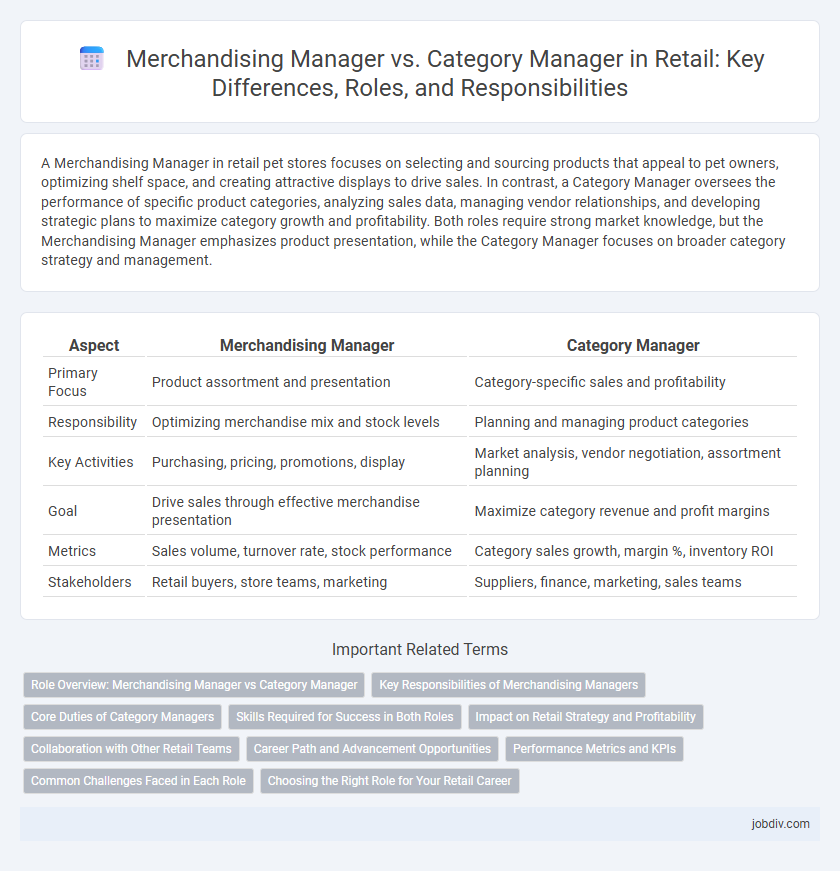A Merchandising Manager in retail pet stores focuses on selecting and sourcing products that appeal to pet owners, optimizing shelf space, and creating attractive displays to drive sales. In contrast, a Category Manager oversees the performance of specific product categories, analyzing sales data, managing vendor relationships, and developing strategic plans to maximize category growth and profitability. Both roles require strong market knowledge, but the Merchandising Manager emphasizes product presentation, while the Category Manager focuses on broader category strategy and management.
Table of Comparison
| Aspect | Merchandising Manager | Category Manager |
|---|---|---|
| Primary Focus | Product assortment and presentation | Category-specific sales and profitability |
| Responsibility | Optimizing merchandise mix and stock levels | Planning and managing product categories |
| Key Activities | Purchasing, pricing, promotions, display | Market analysis, vendor negotiation, assortment planning |
| Goal | Drive sales through effective merchandise presentation | Maximize category revenue and profit margins |
| Metrics | Sales volume, turnover rate, stock performance | Category sales growth, margin %, inventory ROI |
| Stakeholders | Retail buyers, store teams, marketing | Suppliers, finance, marketing, sales teams |
Role Overview: Merchandising Manager vs Category Manager
A Merchandising Manager oversees product selection, pricing strategies, and promotional activities to maximize sales and profitability across multiple categories. A Category Manager focuses on analyzing market trends, managing product assortments, and negotiating with suppliers within a specific category to enhance category performance. Both roles require collaboration with cross-functional teams but differ in scope, with Merchandising Managers handling broader merchandising strategies and Category Managers emphasizing category-specific optimization.
Key Responsibilities of Merchandising Managers
Merchandising Managers are responsible for developing product assortment strategies, managing vendor relationships, and overseeing inventory levels to maximize sales and profitability. They analyze market trends and consumer behavior to ensure optimal product placement and pricing across retail locations. Their role includes coordinating with marketing, sales, and supply chain teams to implement promotional campaigns and optimize shelf space efficiency.
Core Duties of Category Managers
Category Managers drive retail success by analyzing market trends, consumer behavior, and sales data to develop strategic assortment plans that maximize category profitability. They collaborate closely with suppliers and cross-functional teams to optimize product placement, pricing, and promotional strategies within specific product categories. Their core duties include category performance analysis, inventory management, and aligning product offerings with customer demand to enhance overall category growth.
Skills Required for Success in Both Roles
Merchandising Managers excel in product assortment planning, inventory control, and vendor negotiation, requiring strong analytical skills and a deep understanding of consumer buying behavior. Category Managers focus on category performance analysis, strategic pricing, and promotional planning, necessitating expertise in market trends and cross-functional collaboration. Both roles demand proficiency in data analysis, negotiation, and effective communication to drive sales growth and optimize product placement within retail environments.
Impact on Retail Strategy and Profitability
Merchandising Managers drive retail strategy by selecting product assortments and negotiating supplier terms, directly influencing inventory turnover and gross margins. Category Managers optimize profitability through data-driven analysis of customer preferences and competitive pricing, ensuring category growth and market share expansion. Both roles collaboratively enhance retail profitability by aligning product offerings with consumer demand and strategic financial goals.
Collaboration with Other Retail Teams
Merchandising Managers collaborate closely with inventory, marketing, and visual merchandising teams to ensure product placement aligns with overall sales strategies and brand image. Category Managers work alongside pricing, supply chain, and analytics teams to optimize product assortments and category performance based on consumer insights and market trends. Effective collaboration between both roles enhances cohesive retail strategies, driving sales growth and improving customer experience.
Career Path and Advancement Opportunities
Merchandising Managers typically advance by developing expertise in product selection, vendor relationships, and inventory management, positioning themselves for senior roles such as Director of Merchandising. Category Managers focus on strategic planning and market analysis within specific product categories, often progressing toward roles like Category Director or Head of Category Management. Both career paths offer opportunities for advancement through demonstrating strong leadership, data-driven decision-making, and cross-functional collaboration in retail environments.
Performance Metrics and KPIs
Merchandising Managers primarily focus on metrics such as sales growth, inventory turnover rate, and gross margin return on investment (GMROI) to ensure product assortment effectiveness and profitability. Category Managers emphasize category-specific KPIs including market share, category sales volume, and customer basket size to optimize product mix and drive category performance. Both roles monitor stock availability and promotional lift, but Category Managers leverage consumer behavior data for strategic assortment decisions while Merchandising Managers concentrate on supplier negotiations and pricing strategies.
Common Challenges Faced in Each Role
Merchandising Managers often grapple with inventory optimization, supplier negotiations, and ensuring product placement aligns with consumer demand to maximize sales. Category Managers face challenges in analyzing market trends, managing cross-functional teams, and driving category growth through pricing strategies and product assortment. Both roles require balancing customer preferences, sales targets, and operational efficiency within highly competitive retail environments.
Choosing the Right Role for Your Retail Career
Merchandising Managers oversee product selection, pricing strategies, and supplier negotiations to maximize store profitability, focusing on individual product performance. Category Managers analyze market trends and customer behavior to develop comprehensive strategies for entire product categories, aiming to optimize category growth and customer satisfaction. Choosing between these roles depends on your preference for detailed product-level management or broader strategic category oversight within the retail industry.
Merchandising Manager vs Category Manager Infographic

 jobdiv.com
jobdiv.com